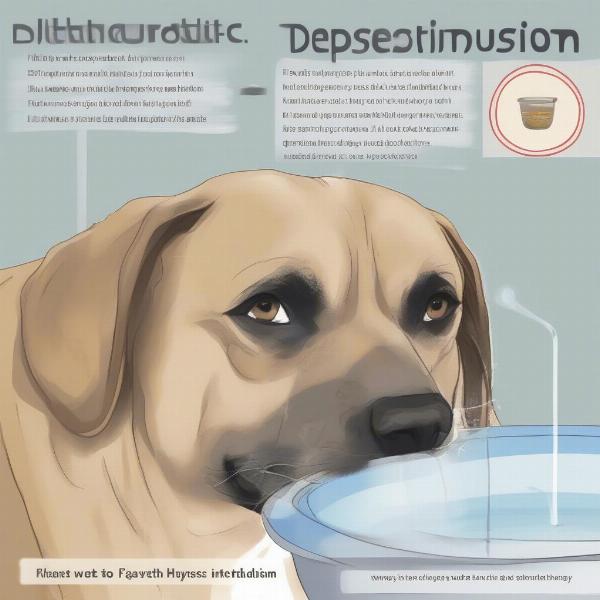Primary hyperparathyroidism (PHPT) is a relatively uncommon endocrine disorder in dogs, characterized by excessive production of parathyroid hormone (PTH) by one or more parathyroid glands. This overproduction leads to elevated calcium levels in the blood, a condition known as hypercalcemia, which can cause a range of health problems. Understanding PHPT, its symptoms, diagnosis, and treatment options is crucial for ensuring the well-being of your canine companion.
 Symptoms of Primary Hyperparathyroidism in Dogs
Symptoms of Primary Hyperparathyroidism in Dogs
Recognizing the Signs of PHPT in Dogs
The symptoms of PHPT in dogs can be vague and often mimic other conditions, making early diagnosis challenging. Some common signs include increased thirst and urination, lethargy, loss of appetite, vomiting, and weakness. As the condition progresses, more severe symptoms such as kidney stones, bladder stones, and even bone fractures can occur. Because these symptoms can be subtle, regular veterinary check-ups are essential for detecting PHPT in its early stages.
Diagnosing Primary Hyperparathyroidism: What to Expect
Diagnosing PHPT involves a combination of blood tests, urine analysis, and imaging techniques. Blood tests will measure calcium, phosphorus, and PTH levels. Elevated calcium and PTH levels, combined with normal or low phosphorus levels, are strong indicators of PHPT. Urine analysis can help assess kidney function and detect the presence of calcium in the urine. Imaging studies, such as X-rays and ultrasound, may be used to identify the affected parathyroid gland(s) and assess for the presence of kidney or bladder stones.
Treatment Options for PHPT in Dogs
The primary treatment for PHPT is surgical removal of the affected parathyroid gland(s). This procedure, called a parathyroidectomy, is often successful in resolving the hypercalcemia and alleviating the associated symptoms. In some cases, medical management with medications to lower calcium levels may be considered, particularly for dogs who are not surgical candidates.
What is the Prognosis for Dogs with PHPT?
With prompt diagnosis and appropriate treatment, the prognosis for dogs with PHPT is generally good. Most dogs experience significant improvement in their symptoms following successful surgery. However, ongoing monitoring of calcium levels is essential to ensure that the condition does not recur.
Long-term Management of PHPT in Dogs
Even after successful treatment, regular veterinary check-ups and blood tests are crucial for monitoring calcium levels and ensuring the dog’s long-term health. Dietary adjustments may also be recommended to support kidney health and prevent the formation of further stones.
Living with a Dog with PHPT: Tips for Owners
Living with a dog diagnosed with PHPT requires commitment to ongoing care and monitoring. Providing a balanced diet, ensuring access to fresh water, and encouraging regular exercise are important for supporting overall health. Closely observing for any recurrence of symptoms and communicating promptly with your veterinarian are crucial for successful management of the condition.
“Early detection is key to managing PHPT successfully. Regular bloodwork can help catch the condition before symptoms become severe.” – Dr. Emily Carter, DVM
high levels of alkaline phosphatase in dogs
Conclusion
Primary hyperparathyroidism in dogs, while relatively uncommon, is a serious condition that requires prompt diagnosis and treatment. By understanding the signs, diagnostic process, and treatment options for PHPT, dog owners can play a vital role in ensuring the well-being of their beloved companions.
FAQ
- What are the first signs of PHPT in dogs? Increased thirst, increased urination, and lethargy are often the first noticeable signs.
- Is PHPT curable in dogs? Surgical removal of the affected parathyroid gland(s) is often curative.
- What is the life expectancy of a dog with PHPT? With proper treatment and management, dogs with PHPT can live a normal lifespan.
- What are the long-term complications of untreated PHPT? Untreated PHPT can lead to kidney damage, bone fractures, and other serious health issues.
- How can I prevent PHPT in my dog? Unfortunately, there is no known way to prevent PHPT, but early detection through regular veterinary check-ups is crucial.
- What kind of diet should a dog with PHPT eat? A diet that supports kidney health and helps prevent the formation of stones may be recommended by your veterinarian.
- Is PHPT painful for dogs? The symptoms associated with PHPT, such as kidney stones, can cause discomfort and pain.
ILM Dog is a leading international online resource dedicated to providing expert advice on dog care and wellbeing. We offer a wealth of information on dog breeds, health, training, nutrition, grooming, and much more. Our mission is to empower dog owners with the knowledge and resources they need to provide the best possible care for their canine companions. Whether you’re a new dog owner or a seasoned expert, ILM Dog is your trusted source for all things dog-related. Contact us today for expert advice and support: Email: [email protected], Phone: +44 20-3965-8624. Visit us at ILM Dog.